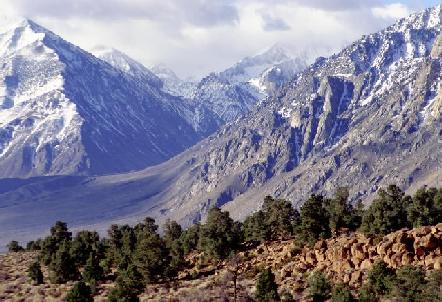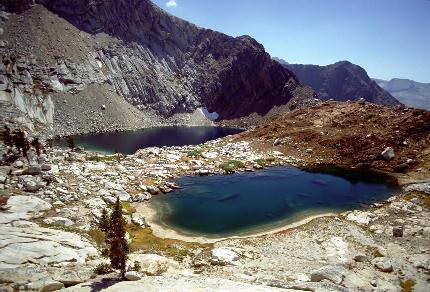Sierra Endangered: A Call to Action
By Mark Winogrond, AICP
Photos by Paul Crawford, FAICP
California is a rare and wondrous state. For many people throughout the world, the unique features of California are their association with the United States. It is no wonder or surprise that 20% of the United States population lives along this relatively narrow band of land running along the Pacific Ocean.
The beauty here is spectacular, at times overwhelmingly so. Our unique geology has created unusually diverse features in close proximity to each other: The beautiful coastline. Rolling hills. Magnificent expanses of desert. And the great Sierra Nevada: The tectonic plates rise and fall; erosion takes its natural course; and we are left with startling beauty.
California has done more to protect its great natural features than any other part of the United States. The State joined together and, in 1972, protected the entire coastline. We are aggressively protecting and restoring our rivers and lakes. We have a statewide biodiversity council working together to protect our unique ecosystems. We are the state in which everyone is an environmentalist: city dwellers and country folk, Republicans and Democrats. We are not sure how it happened, but part of the legacy of California, and now one of its core values, is environmental protection.

We believe this grows in part from California's sense of spirit and freedom. Whether you are a native or were attracted here from some other state (or country), you are drawn because of that almost mystical connection with nature. Clearly that happens because of the proximity to such dramatic icons of nature: crashing waves, large expanses of beaches, magnificent deserts, and mountains so unique that when John Muir discovered them on his walks across the United States, he simply settled down and spent the rest of his life walking the Sierra Nevada range.
We, the California Planning Roundtable, represent the entire state. We come from rural areas; we come from the big cities. We are supposed to act as the "think tank" for the California Chapter of the American Planning Association. We are supposed to be a voice that warns California about issues of statewide concern, and suggests solutions.
In that context, we must tell you that our beloved Sierra Nevada range is deeply at risk. Ironically, this information is not new to many in the Sierra community. There have been numerous environmental studies, workshops and discussions among the representatives of the Sierra communities. The studies have all reached the same conclusion: The Sierra is in danger. While we will not go into any detail here regarding those studies, we do believe it is essential to outline the broad scope of the danger:
- As rugged as the Sierra seems, it really is a very fragile place. Californians are smart people. They have long understood that deserts are fragile even though most places in the country think of deserts as tough, undamageable arenas. We have not yet reached that same level of acceptance regarding the fragility of the Sierra Nevada.
- The population doubled in the Sierra Nevada between 1970 and 1990, and official projections are that the 1990 population will triple by 2040.
- The economy of the Sierra is based on its ecosystem, and yet there is no reinvestment back into the Sierra itself. Water is the most valuable commodity, followed by timber, livestock and other agricultural products. Water accounts for more than 60% of the total gross revenues of the Sierra. Tragically, only 2% of all resource values are at present reinvested into the ecosystem or the local communities.
- The communities in Sierra Nevada are dependent on the just described; however, the economic export system just described is, by definition, not sustainable. Money is made; 98% of it leaves. Virtually nothing comes back to restore the disappearing resource.
- We have seen a significant decline in the number and types of vertebrates, (mammal, birds, reptiles and amphibians). The primary cause is loss of habitat, particularly in the foothills and along the water banks.
- Nearly 6% of California's 7000 plants are found only in the Sierra Nevada, and half of those are rare. Those plants are also at risk because of changes in agriculture and development, particularly along the western slopes of the Sierra.

The Sierra Nevada is a state treasure and a state asset. Its struggle for survival is an urban issue as well as a mountain issue. And yet, as mentioned earlier, the debate about its survival has been virtually exclusively within the Sierra community or the halls of Sacramento.
Many of us do not go to the Sierra Nevada frequently. Many of us only go there a few times in our lives. Many of us only go there on that symbolic pilgrimage in which we take our young children or grandchildren to the top of our state to show them its true majesty. Yet all of us expect that primal majesty to be there when we go up the slopes and we arrive with our successors.
We can no longer guarantee that will be the case. Much as Rachel Carson and the early environmentalists demonstrated what we were doing to the air and water around us in the 1950s and 1960s, the critical studies of the Sierra Nevada demonstrate the fragility of, and serious damage happening to, the Sierra Nevada. This millennium must begin with the agreement that the Sierra Nevada is at risk. The next decade must implement the strategy to protect that precious symbol of California freedom.
Sierra Nevada Action Plan
The California Planning Roundtable has identified certain underlined values and principles which must be in place for any Sierra Nevada strategy to be successful:
- The first is that the local economies which have developed in the Sierra Nevada range must not be abandoned. They must either be sustained or replaced by equally valuable economic strategies.
- Many groups and individuals based in the Sierra Nevada counties and cities have struggled with these issues for years. They should never be left with the feeling that others are coming in from the outside to steal their mountains and take away their authority. They have devoted their lives to the Sierra Nevada range and that must be respected.
- Simultaneously, this issue must be recognized as a statewide issue. Ironically, it is an urban issue.
- The Sierra Nevada must be converted from an almost exclusively export economy to a sustainable economy. Different form the desert (the other fragile) resources of huge value are pulled out of the Sierra on an annual basis; this is particularly true of water. A significant portion of that value must be returned to that in order to protect, restore, and enhance that.
- Regional goals must be established and tracked. We suggest revisiting the Sierra Nevada Ecosystem Project's broad overall goal: maintain the health and sustainability of the Sierra Nevada ecosystem while providing resources to meet human needs. Regional goals cross jurisdictional lines and supersede special interests. Everyone - citizens, local governments, non-profits, state and federal agencies need to work collaboratively to find solutions.
- An independent non-governmental organization must be created to facilitate a statewide strategy for the Sierra Nevada range. That organization might look to models which have worked successfully elsewhere in the state and country (Chesapeake Bay, Hudson River, Tahoe Conservancy, etc.), but we believe that its initial success will be based upon its independent trust and credibility.
